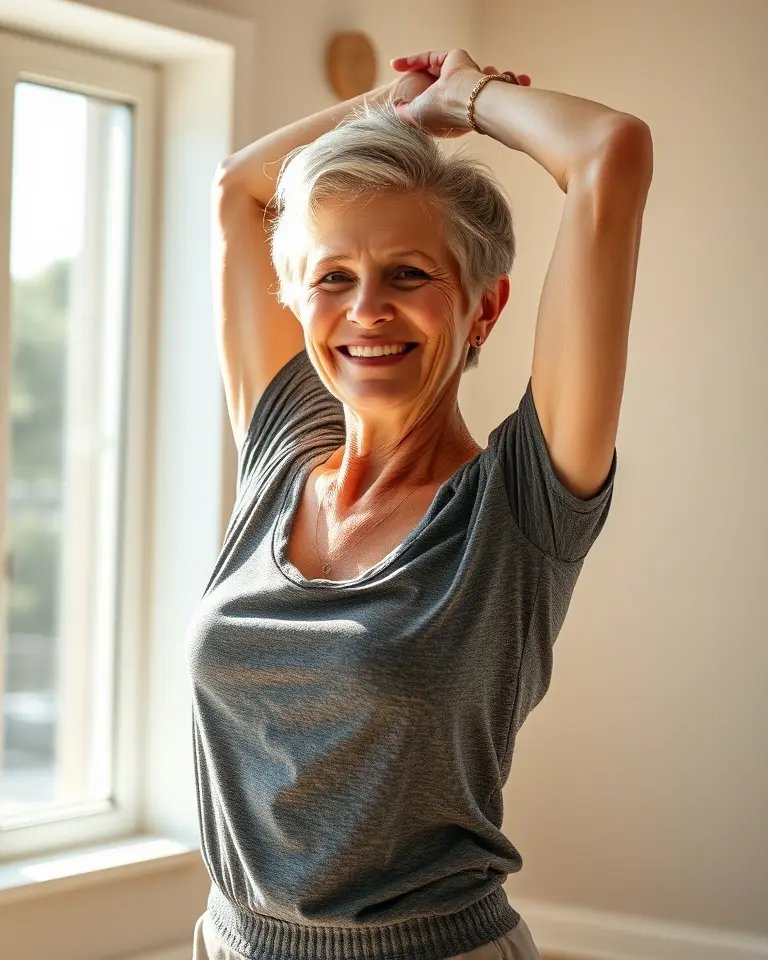Retirement marks a significant life transition, offering a unique chance to prioritize your health and well-being. With more free time available, it’s an ideal opportunity to embark on a fitness journey. Starting a fitness routine after 60 might seem daunting, but it’s entirely achievable with the right approach. Regular exercise can boost energy, improve mobility, and help maintain independence. This article provides four practical tips to help seniors begin and maintain a rewarding fitness routine.
1. Assess Your Current Fitness Level
Before diving into any exercise program, it’s essential to understand your current fitness level. This allows you to choose activities that align with your abilities. A simple yet effective method to gauge your strength is the sit-to-stand test.
How to Perform the Sit-to-Stand Test:
- Sit in a sturdy chair.
- Stand up without using your arms.
- Count how many times you can do this in 30 seconds.
Interpreting Your Results:
- 15 or more repetitions: Indicates good strength and endurance. You can consider more varied and challenging exercises.
- 6-14 repetitions: Suggests moderate strength. Start with low-impact activities and gradually increase intensity.
- 5 or fewer repetitions: Indicates a need to start with gentle movements, focusing on consistency.
This initial assessment will help you tailor a fitness plan that matches your current physical state and avoid overexertion.
2. Set SMART Fitness Goals
Setting realistic and achievable goals is crucial for long-term success and motivation. The SMART framework is an excellent tool for establishing effective fitness goals:
- Specific: Clearly define what you want to achieve. For example, “walk for 20 minutes three times a week.”
- Measurable: Make sure your progress is trackable. For instance, monitor your walking distance or the number of repetitions.
- Achievable: Set goals that are attainable based on your current fitness level. Avoid overwhelming yourself with overly ambitious targets.
- Relevant: Choose goals that align with your overall health and well-being objectives. Focus on activities you enjoy to enhance adherence.
- Time-bound: Establish a timeline to stay accountable and motivated. For example, aim to increase your walking duration each week.
Starting with small, consistent steps will help build momentum and boost your confidence, making fitness a sustainable part of your life.
3. Choose the Right Types of Exercises
A well-rounded fitness routine for seniors should include four key types of exercises: cardio, strength, flexibility, and balance.
Cardio Exercises
Cardiovascular exercises are essential for improving heart health and endurance. These activities increase your heart rate and breathing, enhancing overall physical function. Examples of suitable cardio exercises for seniors include:
- Walking: A low-impact, accessible exercise that can be done anywhere.
- Swimming: Gentle on the joints, providing a full-body workout.
- Cycling: A great way to improve cardiovascular health and leg strength.
- Water Aerobics: Combines the benefits of cardio with the support of water.
Aim for at least 150 minutes of moderate-intensity or 75 minutes of vigorous-intensity cardio per week. It is always advisable to start with shorter durations and gradually increase as your fitness improves.
Strength Training
Strength training is critical for maintaining muscle mass, which naturally declines with age. Building muscle strength not only helps with everyday tasks but also improves balance and bone density, reducing the risk of falls and fractures. Effective strength training activities for seniors include:
- Bodyweight exercises: Such as wall push-ups, calf raises, and squats.
- Lifting light weights: Using dumbbells or resistance bands.
- Functional fitness routines: Focusing on movements that mimic daily activities, such as carrying groceries or getting up from a chair.
The CDC recommends that older adults engage in strength training exercises at least twice a week on non-consecutive days.
Flexibility Exercises
Flexibility exercises are important for maintaining a full range of motion and reducing stiffness in joints. These exercises improve mobility and can alleviate pain associated with conditions like arthritis. Good options for enhancing flexibility include:
- Stretching: Performing gentle stretches that target major muscle groups.
- Yoga: A low-impact exercise that combines stretching, strength, and balance.
- Pilates: Focuses on core strength and flexibility.
Incorporate stretching into your daily routine or after your workouts to maintain and improve flexibility.
Balance Exercises
Balance exercises are crucial for preventing falls, which can have serious consequences for seniors. These exercises enhance stability and coordination, allowing you to maintain independence and confidence. Activities that improve balance include:
- Standing on one foot: Practicing this with or without support.
- Heel-to-toe walking: Walking in a straight line while placing the heel of one foot directly in front of the toes of the other.
- Tai Chi: Gentle movements that improve balance, coordination, and flexibility.
Regularly practicing balance exercises can significantly reduce the risk of falls, promoting better overall health and safety.
4. Create a Manageable Exercise Schedule
Consistency is key to making fitness a long-term habit. Creating a manageable weekly schedule that includes a variety of exercises will help you stay on track. Ensure you incorporate rest days to allow your body to recover. A sample schedule could look like this:
- Monday: 20 minutes of strength training
- Tuesday: 15-minute walk
- Wednesday: Gentle yoga or stretching
- Thursday: Lower body exercises, such as squats or leg lifts
- Friday: Balance-focused activities
- Saturday: Short walk
- Sunday: Rest or light Pilates
This is just an example, and you can adjust the schedule based on your preferences and needs. Always listen to your body and adjust the intensity and duration of your exercises accordingly.
Additional Considerations
Consult Your Doctor
Before starting any new exercise program, it’s crucial to consult with your healthcare provider, especially if you have pre-existing health conditions. They can offer personalized guidance and address any potential limitations or concerns.
Safety First
Prioritize safety by starting slowly and gradually increasing the intensity and duration of your workouts. Always warm up before exercising and cool down afterward to help prevent injuries. Wear appropriate footwear and clothing and stay hydrated. If exercising outdoors, opt for well-lit areas and wear bright or reflective clothing, especially at night. Consider exercising indoors when weather conditions are unfavorable.
Stay Hydrated
Drinking enough water is important, especially for older adults who may be more prone to dehydration. Make sure to stay hydrated before, during, and after your workouts.
Listen to Your Body
Exercise should never cause pain or make you feel lousy. If you feel any discomfort, stop the activity and rest. Adjust the intensity or duration of the exercise as needed and consult with your healthcare provider if problems persist.
Make it Enjoyable
The best way to stick with a fitness routine is to choose activities you enjoy. Make it a social event by exercising with friends or family members. Explore different options and find activities that make you feel good both physically and mentally.
Seek Support
Look for local resources such as senior centers or community fitness programs designed for older adults. These programs often provide a supportive environment and opportunities for social interaction.
The Benefits of Staying Active
Regular exercise offers numerous benefits for seniors, including:
- Prevents Disease: Physical activity can help prevent heart disease, diabetes, and other chronic conditions.
- Improved Mental Health: Exercise can boost mood, reduce stress and anxiety, and improve cognitive function.
- Decreased Risk of Falls: Strength, balance, and flexibility exercises can reduce the risk of falls and help maintain independence.
- Social Engagement: Group exercise classes and activities can promote social interaction and combat loneliness.
- Improved Cardiovascular Health: Cardio exercise helps maintain a healthy heart.
- Maintains Independence: Exercise can improve overall physical function and ability to manage everyday tasks independently.
Staying strong after 60 through regular exercise is entirely possible. By assessing your fitness level, setting SMART goals, choosing a variety of exercises, creating a manageable schedule, and listening to your body, you can make fitness an enjoyable and sustainable part of your retirement life.







